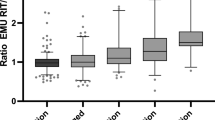Abstract
Objective
Patients with Graves’ disease were studied one year after radioiodine-131 therapy to assess the relationship between the effectiveness of the therapy and the radioiodine doses used.Methods: Patients were classified into three groups according to thyroid function as hyperthyroidism, euthyroidism and hypothyroidism at one year after I-131 therapy. In these groups we compared the mean values of dose, dose per thyroid weight calculated with I-123 uptake before the therapy (pre D/W), dose per thyroid weight calculated with therapeutic I-131 uptake (post D/W), and absorbed dose.
Results
No significant differences were found between the three groups in terms of dose or pre D/W. The mean values of post D/W and absorbed dose in the non-hyperthyroid (euthyroid and hypothyroid) group were significantly greater than those in the hyperthyroid group. Post D/W of 6.3 MBq/g was a threshold separating the non-hyperthyroid group from the hyperthyroid group. There was no correlation between pre D/W and post D/W; however, the mean post D/W was significantly greater than the mean pre D/W. All patients with pre D/W above 6.3 MBq/g showed non-hyperthyroidism at one year after the radioiodine treatment.
Conclusions
No indicators before the radioiodine therapy had significant relationships with the effectiveness of the therapy at one year after the treatment. However, the single therapy planned for setting the pre D/W above 6.3 MBq/g will certainly make the patients non-hyperthyroid. As this proposal of dose planning is based on a small number of patients, further study is needed.
Similar content being viewed by others
References
Glinoer D, Hesch D, Lagasse R, Laurberg P. The management of hyperthyroidism due to Graves’ disease in Europe in 1986: results of an international survey.Acta Endocrinol 1987; 185 (Suppl):9–37.
Nagayama Y, Izumi M, Nagataki S. The management of hyperthyroidism due to Graves’ disease in Japan in 1988.Endocrinol Jpn 1989; 36:299–314.
Solomon B, Glinoer D, Lagasse R, Wartofsky L. Current trends in the management of Graves’ disease.J Clin Endocrinol Metab 1990; 70:1518–1524.
Catargi BC, Leprat F, Guyot M, Valli N, Ducassou D, Tabarin A. Optimized radioiodine therapy of Graves’ disease: analysis of the delivered dose and of other possible factors affecting outcome.Eur J Endocrinol 1999; 141:117–121.
Nordyke RA, Gilbert FI. Optimal iodine-131 dose for eliminating hyperthyroidism in Graves’ disease.J Nucl Med 1991; 32:411–416.
Bruin TWAD, Croon CDL, Klerk JMH, Isselt JWV. Standardized radioiodine therapy in Graves’ disease: the persistent effect of thyroid weight and radioiodine uptake on outcome.J Intern Med 1994; 236:507–513.
Howarth D, Epstein M, Lan L, Tan P, Booker J. Determination of the optimal minimum radioiodine dose in patients with Graves’ disease: a clinical outcome study.Eur J Nucl Med 2001; 28:1489–1495.
Allahabadia A, Daykin J, Sheppard MC, Gough SCL, Franklin JA. Radioiodine treatment of hyperthyroidism- prognostic factors for outcome.J Clin Endocrinol Metab 2001; 86:3611–3617.
Shapiro B. Optimization of radioiodine therapy of thyrotoxicosis: what have we learned after 50 years?J Nucl Med 1993; 34:1638–1641.
Eriksson E, Eriksson K, Wahlberg P. Treratment of hyper- thyroidism with standard doses of radioiodine aiming at ablation.Acta Med Scand 1985; 217:55–60.
Ratcliffe GE, Fogelman I, Maisey MN. The evaluation of radioiodine therapy for thyroid patients using a fixed-dose regime.Br J Radiol 1986; 50:1105–1107.
Willemsen UF, Knesewitsch P, Kreisig T, Pickardt CR, Kirsch CM. Functional results of radioiodine therapy with a 300-Gy absorbed dose in Graves’ disease.Eur J Nucl Med 1993; 20:1051–1055.
Gomez N, Gomez JM, Orti A, Gavalda L, Villabona C, Leyes P, et al. Transient hypothyroidism after iodine-131 therapy for Graves’ disease.J Nucl Med 1995; 36:1539- 1542.
Aizawa Y, Yoshida K, Kaise N, Fukazawa H, Kiso Y, Sayama N, et al. The development of transient hypothyroidism after iodine-131 treatment in hyperthyroid patients with Graves’ disease: prevalence, mechanism and prognosis.Clin Endocrinol 1997; 46:1–15.
Khanna CM, Sankar R, Magdum M, Gera A. Early development of transient hypothyroidism after I-131 therapy for thyrotoxicosis.J Assoc Physicians India 1998; 46:268- 272.
Malone JF, Cullen MJ. Two mechanisms for hypothyroidism after131I therapy.Lancet 1976; 2:73–75.
Goolden AWG, Stewart JSW. Long-term results from graded low dose radioactive iodine therapy for thyrotoxicosis.Clin Endocrinol 1986; 24:217–222.
Farrar JJ, Toft AD. Iodine-131 treatment of hypothyroidism: current issues.Clinl Endocrinol 1991; 35:207–212.
Nygaard B, Hegedüs L, Gervil M, Hjalgrim H, Hansen BM, S¢e-Jensen P, et al. Influence of compensated radioiodine therapy on thyroid volume and incidence of hypothyroidism in Graves’ disease.J Intern Med 1995; 238:491–497.
Marinelli LD, Quimby EH, Hine GJ. Dosage determination with radioactive isotopes.Am J Roentgenol 1948; 59:260- 281.
Author information
Authors and Affiliations
Corresponding author
Rights and permissions
About this article
Cite this article
Kita, T., Yokoyama, K., Kinuya, S. et al. Single dose planning for radioiodine-131 therapy of Graves’ disease. Ann Nucl Med 18, 151–155 (2004). https://doi.org/10.1007/BF02985106
Received:
Accepted:
Issue Date:
DOI: https://doi.org/10.1007/BF02985106




